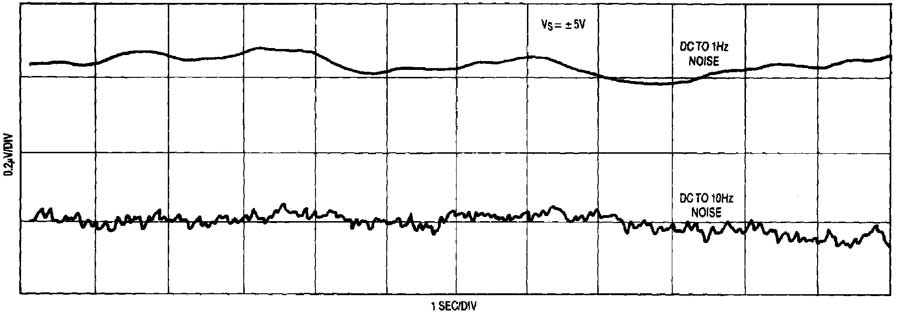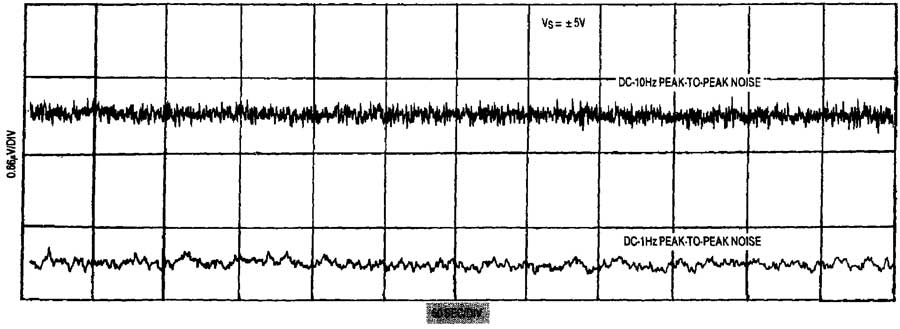Design Note 36: Ultra Low Noise Op Amp Combines Chopper and Bipolar Op Amps
Chopper op amp technology has continuously improved. Contemporary single, dual and quad low noise chopper op amps (LTC1050/51/53), with internal sample and hold capacitors, are compatible with industry standard op amp sockets.
Chopper op amps are mainly used to amplify small DC signals and these applications require excellent VOS, VOS drift, low bias current and low noise. The outstanding VOS performance of chopper op amps is well known. However, their low frequency noise compared to precision bipolar op amps is at least an order of magnitude higher. For applications which require both ultra low VOS drift and ultra low noise, neither bipolar nor chopper op amps are optimum. A circuit combining the superior DC performance of the dual chopper LTC1051 with the ultra low noise voltage of the LT1007 precision bipolar op amp appears in Figure 1. This composite op amp can, for instance, be used as a strain gauge amplifier. One half of the LTC1051 dual chopper op amp, LTC1051, integrates the small LT1007 input offset voltage and applies a DC correction voltage at its pin-8 via divider (R2, R3). The other half of the LTC1051, buffers the VOS nulling circuitry eliminating loading at input A. Resistors R1, R2, R3 allow the integrator full output swing assuring VOS correction of the LT1007. The ratio of R3 to R2 is made as high as possible to limit noise injection of the chopper into pin-8 of the bipolar op amp. The total measured input VOS was 2μV, with a 10nV/°C drift.

Figure 1. Combining the Low VOS and VOS Drift of the Dual Chopper LTC1051 with the Low Noise of a Precision LT1007 Bipolar Op Amp.
Noise Measurements
Bipolar op amp data sheets commonly specify 0.1Hz-10Hz peak-to-peak noise measured during a period of 10 sec. (or “10 sec. window”). The peak-to-peak noise is the difference of the highest positive noise spike to the lowest negative noise spike occurring during the 10 sec. interval. When working with chopper op amps, it is very tempting to apply this 10 sec. window test for noise measured from DC to 10Hz. In fact, the LTC1051 zeros its VOS at a 2.5kHz rate, so it is reasonable to assume its noise spectral density continues to be “flat” below 0.1Hz. Experiments prove this assumption to be quite valid since the 0.1Hz to 10Hz peak-to-peak noise dominates the DC to 0.1Hz noise. For the composite op amp of Figure 1, however, the assumption may not be correct. The 0.1Hz to 10Hz noise of the LT1007 is at least an order of magnitude lower than the LTC1051 noise. Assuming that only a minute portion of the LTC1051 noise is injected into the LT1007 offset pin, then most 10 sec. windows should show outstanding noise results. Figure 2 shows this is so. Notice that for both DC-1Hz, and DC-10Hz bandwidths the peak-to-peak noise was 100nV!! Any additional noise, therefore, should be contributed by the ultra low frequency “hunting” of the VOS adjusting circuit’s, integrator loop. Figure 3 shows the noise recorded in a 10 minute period. Again, results are quite impressive. The DC to 10Hz peak-to-peak noise is about the same as the DC to 1Hz peak-to-peak noise. The 0.2μVP-P recorded represents a 7 to 9 times improvement over the LTC1051 DC to 10Hz noise measured under the same conditions, and a 2.5 times improvement of the equivalent DC to 1Hz noise. The turn-on settling time of the circuit is 16 sec. Once the integrator captures the VOS, the circuit’s response time is undistinguishable from a normal amplifier. The circuit of Figure 1 should be used with source resistances less than 1kΩ to maintain noise performance.

Figure 2. Recorded Peak-to-Peak Noise of the Composite Op Amp, Figure 1, During a 10 Sec. Window.

Figure 3. Recorded Peak-to-Peak Noise of the Composite Op Amp, Figure 1, During a 10 Minute Window.
